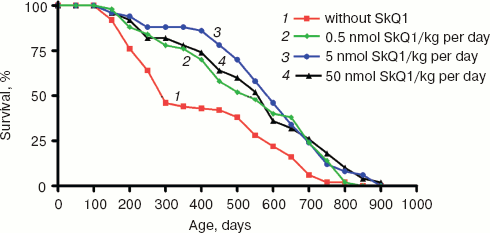http://groups.google...02ca24?lnk=raot
Also, check out the fightaging.org write-up on SkQ1 on Jan. 16, 2009
http://fightaging.org/
Entry titled: Other Parties Interested in Targeting Mitochondria

Posted 17 January 2009 - 05:05 PM
Posted 17 January 2009 - 06:23 PM
Posted 17 January 2009 - 09:19 PM
Posted 17 January 2009 - 11:37 PM
Posted 18 January 2009 - 12:54 AM
I think the yadda yadda part is the important part, though. First median life span is nice and all but pretty worthless in terms of real life extension and I have a hard time finding data on maximum life span.huh... looks like you don't have to move the mitochondrial DNA into the nucleus after all... you just have to treat the mitochondria nicely. I really didn't think MitoSENS would be the first of the seven to yield this kind of breakthrough; assuming, of course, that this all pans out and translates to humans, yada yada.
Edited by kismet, 18 January 2009 - 12:56 AM.
Posted 18 January 2009 - 01:33 AM
Posted 18 January 2009 - 10:11 PM
Edited by AgeVivo, 18 January 2009 - 10:13 PM.
Posted 19 January 2009 - 03:03 AM
Posted 19 January 2009 - 09:57 AM
I don't think rodents are the perfect modell organism in the first place (at least they're rather cheap), but I guess that isn't what you were saying. What better strains are there? Wild mice? The NIA's genetically heterogeneous lab mice?Heh, I'm afraid when it comes to human-like aging, BL6 is quite a genetic four letter word in itself.
Posted 19 January 2009 - 08:47 PM
Yes, that is exactly what I'm saying. There are no generally "good" models. So I think it's not right to blame the Russians specifically for choosing a poor model. So does everybody.I don't think rodents are the perfect modell organism in the first place (at least they're rather cheap), but I guess that isn't what you were saying.
Posted 19 January 2009 - 10:13 PM

Posted 21 January 2009 - 05:53 AM
Posted 21 January 2009 - 06:20 AM
Edited by mixter, 21 January 2009 - 12:10 PM.
Posted 21 January 2009 - 02:17 PM
I think the argument is that BL6 generally live longer (max and average life span) than SHR mice for instance, having a longer natural life span, one could assume that their bodies have better repair mechanisms for aging damage and cope better with or develop less pathologies. If they develop pathologies and your supplement happens to treat them voilá fake life extension.I absolutely agree. What I'm saying is BL6 is highly abnormal too. Why specifically would you think that BL6 is in any way a better model for whatever it is that you care about than these strains?
Edited by kismet, 21 January 2009 - 02:18 PM.
Posted 26 January 2009 - 03:11 PM
They don't die early of specific pathologies; their survival curves (when properly husbanded) are nice and square; and they have about as long a lifespan as Mus musculus gets. What all of this suggests is that when you see their lifespans improved, you're not just putting off early mortality or preventing some specific disease (which is what we've been doing in humans for the last century or more), but are doing something that intervenes in the global aging of the mouse.I absolutely agree. What I'm saying is BL6 is highly abnormal too. Why specifically would you think that BL6 is in any way a better model for whatever it is that you care about than these strains?
Posted 27 January 2009 - 07:44 PM
Posted 27 January 2009 - 07:55 PM
If we start creating inbred human strains with specific genetic defects, this will be a problem. For normal human populations, we need to use a sufficiently large sample to represent normal diversity, but that's about it. Pharmacogenomics will address the problems that come up with genetic variation in, for example, drug metabolism.If there's this much debate about methodology because they didn't choose a specific strain of mice, how are we supposed to extrapolate any of this to "a specific strain" of humans, much less all humans?
Posted 27 January 2009 - 08:00 PM
Edited by PetaKiaRose, 27 January 2009 - 08:00 PM.
Posted 27 January 2009 - 09:20 PM
I can only guess that the answer is: yes, they do, just what are the real benefits? As obviously the mice are not as perfectly heterogenous as, say, huge human cohorts*I imagine that the current model would work well for certain areas of Kentucky and Apppalachia

Do they do any studies on large, genetically diverse populations of mice, or is this too impractical? I apologize, clearly we have a room full of experts here with a few laymen interjecting.
I interjected the question in the hope someone would notice and start a debate on their (possible) advantages....What better strains are there? Wild mice? The NIA's genetically heterogeneous lab mice?Heh, I'm afraid when it comes to human-like aging, BL6 is quite a genetic four letter word in itself.
Posted 29 January 2009 - 12:52 PM
Posted 30 January 2009 - 05:14 AM
Edited by Aphrodite, 30 January 2009 - 05:15 AM.
Posted 30 January 2009 - 05:46 AM
There was a great article written over on Ouroboros on SkQ1 on Jan. 28
SkQ1: A mitochondrially targeted antioxidant that extends lifespan
Posted 31 January 2009 - 05:19 PM
- Intervention Testing Program = robust tests of life-extension in mice: officious page - official pageDo they do any studies on large, genetically diverse populations of mice, or is this too impractical?
What i read is that SkQ1 was built by V.P.Skulachev's team. In http://protein.bio.m...l/73121641.html ,"To the right eye, Vetomitin, a pharmaceutical form of SkQ1, was daily instilled whereas the left eye was used as a control to the SkQ1 treatment"Is SkQ1 available to take in supplement form? Or is it found in anything available in nature?
Edited by AgeVivo, 31 January 2009 - 05:37 PM.
Posted 31 January 2009 - 06:20 PM
Good article. Didn't answer my first question though, is this skq1 commonly found in a current supplement, fruit, vegetable, etc.?
CrepThere was a great article written over on Ouroboros on SkQ1 on Jan. 28
SkQ1: A mitochondrially targeted antioxidant that extends lifespan
Posted 15 March 2009 - 10:34 PM
I looked at Ceriodaphnia affinis. They saytheir good knowledge of longevity models (Podospora anserina, Ceriodaphnia affinis, fruit flies)!
I googled a little. In fact Ceriodaphnia affinis is a synonym for sor Ceriodaphnia dubia, which i a much more common name. It's a sort of small/tiny schrimps that eat algua and that anyone can culture in glass bottles but the issue i see for lifespan tests (except that it is not a human ;-) is that C. dubia is extremely sensitive to toxics. In fact it is generally used to test if water is safe (if it isn't C. dubia dies).The crustacean C. affinis is a convenient subject for lifespan research since its imago life cycle is usually as short as 15-20 days and cultivation under laboratory conditions is not a problem
Posted 21 April 2009 - 06:10 PM
0 members, 0 guests, 0 anonymous users